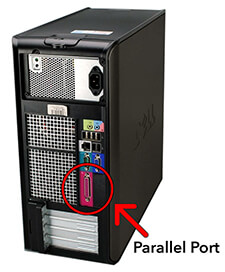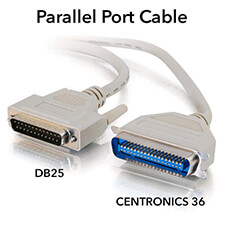Parallel Port
A parallel port is an external interface commonly found on PCs from the early 1980s to early 2000s. It was used to connect peripheral devices such as printers and external storage devices. It was eventually superseded by USB, which provides a smaller connection and significantly faster data transfer rates.
The parallel port is a hallmark of old computer technology — large in size and slow in speed. A standard parallel port connector has two rows of 25 total pins surrounded by a metal casing. It is roughly an inch in width and has two screw-in connectors to keep the cable in place. Parallel port cables used for printing often have an even larger 36-pin "Centronics 36" connector that connects to the printer. The original parallel port standard was unidirectional and could transmit data at a maximum speed of 150 kbps.
As printers became more advanced, it was necessary to increase the connection speed and also provide bidirectional communication. Instead of the PC sending a "print" command and hoping the print job was successful, the bidirectional capability allowed printers to send messages back to the PC, such as "ready," "printing," and "complete." Faster transmission speeds enabled the parallel port to be used for other purposes, such as external storage devices like the Iomega Zip drive.
IEEE 1284
The parallel port was eventually standardized by the IEEE as "IEEE 1284." This standard defined new versions of the parallel port, including the Enhanced Parallel Port (EPP) and the Extended Capability Port (ECP). EPP could transmit data up to 16 Mbps (2 MB/s). ECP could achieve data transfer rates close to 20 Mbps or 2.5 MB/s via an ISA bus.
While the first version of USB was not much faster than a parallel port, it offered other improvements, such as a smaller connector and the ability to send electrical voltage to power an external device. It also was hot-swappable, meaning a USB device could safely be connected or disconnected while a computer was running. Connecting or disconnecting a peripheral via an IEEE 1284 connection could damage the device or the PC. The introduction of USB 2.0, which provided data transfer rates of 480 Mbps, made the parallel port obsolete, and the IEEE 1284 standard faded into computer history.
 Test Your Knowledge
Test Your Knowledge
